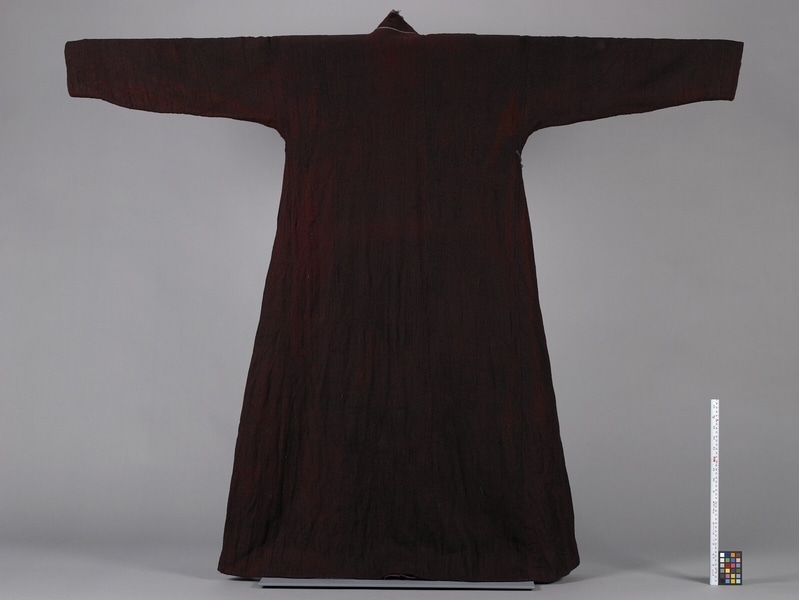Coat Item Number: Ee73 from the MOA: University of British Columbia


Description
Men’s long, A-line, long sleeved coat with high Mandarin collar. Left front extends over right front and fastens with brass ball buttons and decorative loops, located at centre front, and at the right side seam under the sleeve. Collar and left front extension are edged with decorative piping. Made of dark red coarsely woven wool textile. The textile was woven in narrow strips (about 20 cm) that are pieced together at the selvages to provide sufficient widths. All edges are faced with bias strips of light-coloured cotton or silk broadcloth (roughly 5 cm wide). Hand sewn.
History Of Use
Typically Tibetan style man's coat called a kos or gyazo. Part of traditional everyday costume for men. May be white or dark. It is held closed at the waist with a sash (such as Ee66). It is held closed with a sash (skirax) at the waist. The deep red colour is traditional; white may also be used. This garment is made in Ladakhi households, and is not usually available for sale. This style of garment is worn throughout the Himalayas and Central Asia. Features, such as a high neckline, double layer over the chest, extra long sleeves, and long flowing lower part, are adaptive to cold windy climate and horse travel. The wool for the textile is produced in the home. Sheep are shorn once a year, and the wool is processed, spun, woven on a narrow loom and dyed in the home. The resulting textile measures about 20 cm in width. Sewn by hand, using traditional techniques. Similar to other garments worn throughout the Himalayan region, which are adaptive to a cold, windy climate and horse travel. Today wool textiles are available in the marketplace, replacing the need to produce them in the home.
Narrative
A kos was not available in the market, and most Ladakhis own only one. This example was purchased by the collector from an intermediary.
Item History
- Made in Jammu-Kashmir, India before 1977
- Collected in Jammu-Kashmir, India during 1977
- Owned by John Calder and Gloria Masse before May 5, 1978
- Received from John Calder (Seller), Gloria Masse (Seller) and Museum of Anthropology Donations Fund (Funding source) on May 5, 1978
What
- Name
- Coat
- Identification Number
- Ee73
- Type of Item
- coat
- Material
- wool fibre, silk fibre ?, brass metal, cotton fibre ? and dye
- Manufacturing Technique
- cut and stitched
- Overall
- height 140.5 cm, width 172.5 cm
Who
- Culture
- Ladakhi
- Previous Owner
- John Calder and Gloria Masse
- Received from
- John Calder (Seller), Gloria Masse (Seller) and Museum of Anthropology Donations Fund (Funding source)
Where
- Holding Institution
- MOA: University of British Columbia
- Made in
- Jammu-Kashmir, India
- Collected in
- Jammu-Kashmir, India
When
- Creation Date
- before 1977
- Collection Date
- during 1977
- Ownership Date
- before May 5, 1978
- Acquisition Date
- on May 5, 1978
Other
- Item Classes
- textiles
- Condition
- good
- Accession Number
- 0426/0028